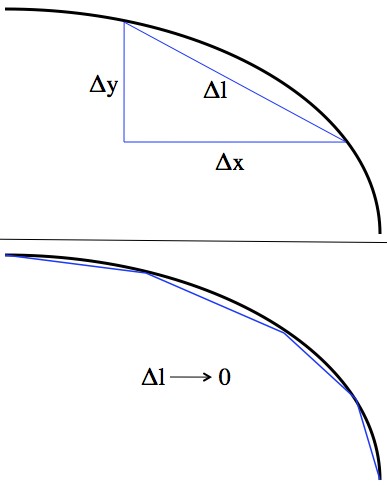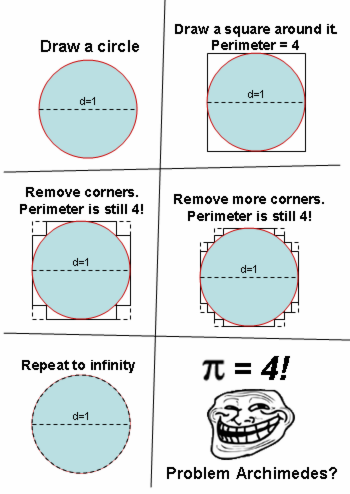Physicist: Recently this picture has been floating around confusing everyone, and making people think that maybe Indiana wasn’t completely off base when they moved to declare that .
The exact answer to this question comes from deep in the field of mathematical analysis, which is where mathematicians go to think up worse-case scenarios. That answer is long and uninteresting. This answer is better.
This zig-zag path does approach the circle, so on the surface of it you’d expect that it would have the same length. However, the length of a curve is more a function of it’s derivative (slope), and less a function of its position. If you were to throw a jumbled up 20 foot rope into a 1 foot box, you wouldn’t say that the box is 20 feet across. You’d want to straighten the rope out before you draw any conclusions.

To find the length of a curve you approximate it with lots of straight lines, then let the number of those lines go to infinity, and the lengths of the individual lines go to zero.
Using the Pythagorean theorem: . So if the total length of the curve is L, then by adding up all the little pieces you can get a good approximation:
When the lengths get very small (that is, when ),
becomes
,
becomes
, and
becomes
. This is just a Riemann sum.
Now you have (one version of) the arclength equation: ! Notice that the approximation has now become an equality.
If you were/are a calculus student, that “dy/dx” probably just set off some alarms in your head. dy/dx is the “derivative of y with respect to x”. If you were to make a graph of y vs. x, it would be the slope of the graph, and (this is the important part) L depends on it explicitly.
So finally, to answer the question, in order to approximate a path with another path, in such a way that they end up having the same length, you must be careful to make sure that the two paths have the same slope along their entire length.
As an aside: The “problem Archimedes?” thing is a reference to Archimedes’ approximation of using polygons. If you inscribe an N-gon (an N-sided polygon) into a circle, the length of it’s perimeter is:
, where D is the diameter of the circle.
In this case, since the higher the number of sides the n-gon has, the better it approximates the circle both in position and slope, you’ll find that as ,
! The
inside the Sine function falls out of the definition of “radians“, and basically boils down to the usual definition.









23 Responses to Q: π = 4?